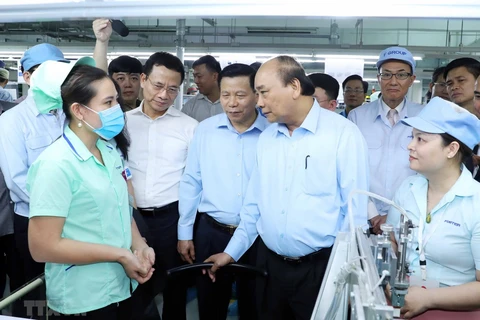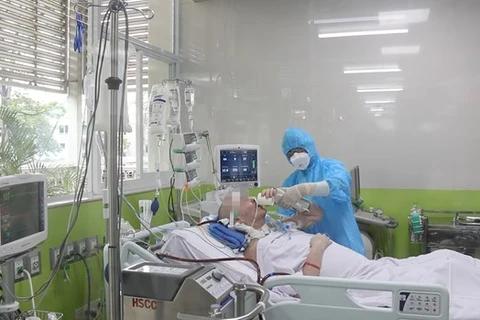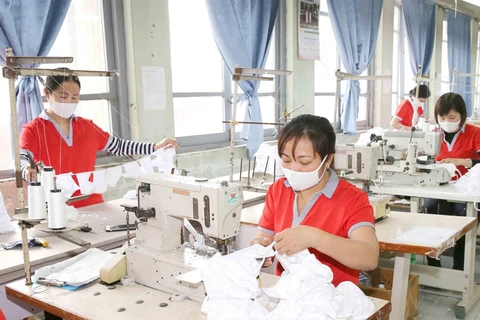 Various firms have to ask workers to alternately take temporary leave and reduce work hours due to COVID-19 (Photo: VietnamPlus)
Various firms have to ask workers to alternately take temporary leave and reduce work hours due to COVID-19 (Photo: VietnamPlus) Hanoi (VNA) – Loans for temporary leave pay are expected to help firms retain skilled workers and mitigate the number of laid-off workers triggered by the COVID-19 pandemic.
Vietnam’s labour force has hit rock bottom due to the impacts of the COVID-19 pandemic. The number of employed workers in the second quarter tumbled 2.4 million from the previous quarter and 2.6 million compared to the same period last year, the worst in the last 10 years.
Urban unemployment rates also hit a record high in the last decade. Even so, the number of dismissals is projected to increase in the third quarter.
In an interview, Deputy Minister of Labour, Invalids and Social Affairs (MoLISA) Le Quan explained the aid package worth 62 trillion VND (2.67 billion USD) aiming to stabilise the labour force in the context of the pandemic.
Reporter: The Q3 is forecast to be the peak of the unemployment rate as more workers will be dismissed in line with the slump of export orders. What is your view on this case?
Mr Le Quan: The trend of cut-downs will depend on sectors, fields and enterprises. Firms often classify labourers into three groups. The first group comprises those whose contracts will be ended immediately to reduce costs. The second is suitable for temporary leave, but difficult to recruit and often requires high training costs.
The final group is obviously deemed the “backbone” of enterprises.
The estimated peak of unemployment in July and August is set to affect workers who are fast to recruit and train. Firms that do not receive orders will have to reduce the number of workers. As a result, this group is the most vulnerable.
Reporter: How will the Government support labourers?
Mr Le Quan: A scenario to support firms in the last six months will be built in tandem with the development of the job market. For firms that have to cut down on the number of work hands, the furloughed will receive unemployment allowances.
Meanwhile, the Government will provide loans for some enterprises to help them pay temporary leave for workers. Firms are still responsible for paying salary for their key employees, and for others if they continue operations.
Reporter: As of July 16, only one firm had been able to access the loans. What did the MoLISA do to loosen conditions?
Mr Le Quan: Many firms are predicted to face hardship in the last six months of this year. The Government decided to maintain the loan cap and maturity, but extend the duration to borrow loans for temporary leave.
Businesses are allowed to borrow money for a maximum of three months and for temporary leave between January 1 and December 12 this year, instead of just from April to June.
Conditions on proving financing situation have also been loosened. Loans used to be solely for those with financial troubles, but now firms with workers taking temporary leave are eligible.
Reporter: Some people have voiced their concerns that, as conditions are loosened, a large number of firms will vie for the aid package. What is your view on this case?
Mr Le Quan: Not many businesses will borrow money to pay salary for workers since other aid packages are available. Meanwhile, this aid is only for firms that do not want to fire their workers.
Reporter: There are workers who have to take temporary leave but have yet to receive assistance, can you clarify the situation?
Mr Le Quan: Many workers may not be beneficiaries due to non-compliance with the law.
This group of workers are asked to take leave unlawfully, while not able to receive unemployment allowances. The MoLISA has urged localities to review the situations. In such cases, the labour federations play a significant role in protecting the rights of labourers.
Reporter: At this time, what are the solutions to mitigate the negative impact of COVID-19 on the labour market?
MR Le Quan: Unemployment insurance premiums must be fully paid so that when numerous people lose their jobs due to the economic crisis, the unemployment allowance will be sufficient to cover basic living standards. In addition, the fund can be used to help workers change their occupations.
The fund has been accumulated over the years to about 90 trillion VND, now is the right time to utilise it.
If we manage to bring the pandemic under control, we may boost the labour force for the upcoming post-pandemic period.
Reporter: Thank you so much!/.

























